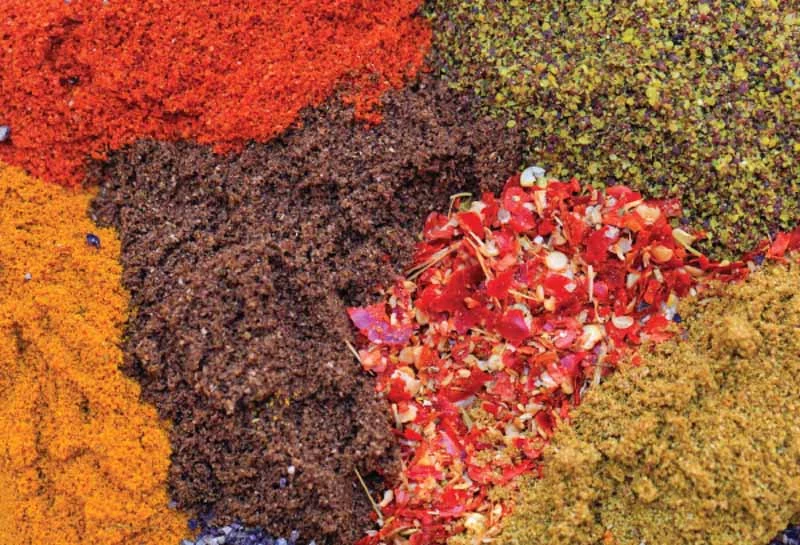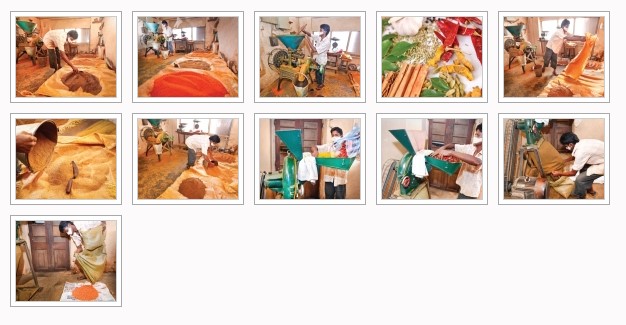
The pungency and aroma were simply senses-rousing.That helped belie the not-so flashy surroundings of a very typical Sri Lankan spice shop, well-known in everyday parlance as a ‘grinding mill’. The term, as is evident, is a feature of Sri Lanka’s impressive dialect and a perfect translation of its Sinhala phrase. The all too familiar ‘hot and spicy’ tag that Sri Lankan food is popular for, is owing to the blend of tangy spices that are powdered in different blends at such inconspicuous mills.
Words Jennifer Paldano Goonewardane Photographs Damith Wickramasinghe
The Sri Lankan ‘grinding mill’ though, is quite an old feature of urban, suburban and semi-rural life and has survived the advent of modernity. It provided a welcome alternative to the laborious household practice of pounding ingredients with a pestle in a mortar. In fact, accessing the good-old ‘grinding mill’ is simple and within reach. Not only do people get the necessary spices and curry powders ‘pounded’ at an affordable price, the mills also sell their distinctive variety of curry powders. From the regular chilli powder, coarse chilli powder, pepper, coriander and cinnamon powders, curry powders made to special recipes and varying ingredients are ground and sold at these local grinding mills.
Grinding mills will not become a feature of the past any time soon, despite the many modern devices that help people make their curry powders in the confines of their homes. The grinding mill still retains the advantage of pounding mixtures in large quantities, a difficult task for a regular home grinder.
Grinding Mills Are Still Sought, Because There Are Locals Who Desire Authentic Sri Lankan Curry Powders Ground ‘Without A Flaw’ At A Traditional Grinding Mill
The long-established function of a Sri Lankan grinding mill has been to accept the many spices and mixtures that were brought by customers for grinding. The process begins with the weighing of portions and the price is determined accordingly. Of course the workers have to check the type of mixture and tag it, lest it accidentally goes into the wrong machine. Opting for a grinding mill is in fact quite affordable, when ingredients that weigh 1kg would cost no more than 80 rupees to be milled.
Grinding mills are still sought, because there are locals who desire authentic Sri Lankan curry powders ground ‘without a flaw’ at a traditional grinding mill. This is of course notwithstanding the long-standing belief among womenfolk that grinding mills ‘pinch’ from customers’ portions.
Dried Chilli is the most ground spice even today as it is a common ingredient in all Sri Lankan dishes. The mill makes its own variety of curry powders that are prepared separately for meat dishes; a separate curry powder for fish, chicken and beef and roasted curry powder for ‘black curries’ such as jackfruit and mango and an unroasted curry powder for mild vegetable dishes.
At the Oriental Grinding Mill, a very old site in a very busy street in Colombo, every ingredient that is used to make their curry powders is washed to take off the sand and other muck and dried completely before it is processed. Roasted curry powder is made by roasting all the ingredients in a pan to a darker colour, slightly blackened, which actually makes it much more piquant than the unroasted curry powder. The difference between roasted and unroasted curry powder, is that the former contains chilli and the more aromatic cloves, cardamoms, cinnamon, cumin, sweet cumin and garlic.
This grinding mill has arranged its daily operations in a very cost effective manner. All work relating to the mill is completed in the morning, while customers’ orders are collected right through the morning. Customers’ orders are filled into machines only in the afternoon. Operating with four large machines, generally chilli powder, roasted and unroasted curry powders are milled in one machine; of course separately and after the residue of the earlier mixture are wiped clean off the machine. Varieties of flours are also milled in separate machines, which naturally makes the term ‘grinding mill’ quite generic. The aroma of brewing spices may be very stimulating to the occasional visitor to the mill, but for the regular worker, everything that contains chilli can be quite a ‘burning’ experience. Of course, with time, as always is the case, one adapts to the many stinging effects of spices and donning a mask becomes part of one’s job.
Grinding mills of the day have become efficient with newest machinery operating on electricity and quicker in completing the process. Still some of them, like this grinding mill, retain the old manually operated weighing scales that use large metal plates with different weights engraved on them. How the weight is determined is quite unimaginable. But of course one is made to believe that experience may have made the workers masters in their trade.



